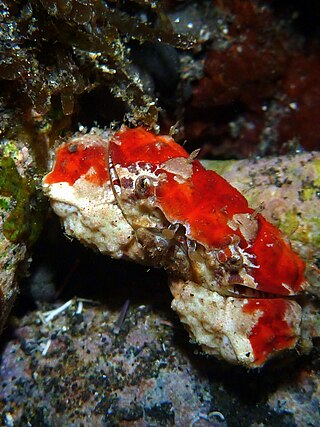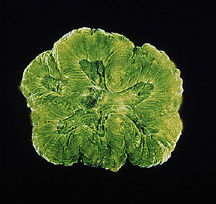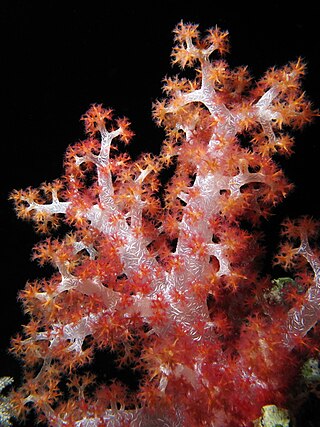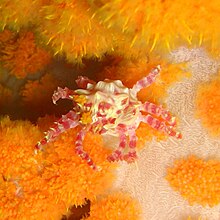
Zoanthids are an order of cnidarians commonly found in coral reefs, the deep sea and many other marine environments around the world. These animals come in a variety of different colonizing formations and in numerous different colors. They can be found as individual polyps, attached by a fleshy stolon or a mat that can be created from small pieces of sediment, sand and rock. The term "zoanthid" refers to all animals within this order Zoantharia, and should not be confused with "Zoanthus", which is one genus within Zoantharia.

Alcyonacea are an order of sessile colonial cnidarians that are found throughout the oceans of the world, especially in the deep sea, polar waters, tropics and subtropics. Whilst not in a strict taxonomic sense, Alcyonacea are commonly known as soft corals. The term "soft coral" generally applies to organisms in the two orders Pennatulacea and Alcyonacea with their polyps embedded within a fleshy mass of coenenchymal tissue. Consequently, the term "gorgonian coral" is commonly handed to multiple species in the order Alcyonacea that produce a mineralized skeletal axis composed of calcite and the proteinaceous material gorgonin only and corresponds to only one of several families within the formally accepted taxon Gorgoniidae (Scleractinia). These can be found in order Malacalcyonacea (taxonomic synonyms of include : Alcyoniina, Holaxonia, Protoalcyonaria, Scleraxonia, and Stolonifera. They are sessile colonial cnidarians that are found throughout the oceans of the world, especially in the deep sea, polar waters, tropics and subtropics. Common names for subsets of this order are sea fans and sea whips; others are similar to the sea pens of related order Pennatulacea. Individual tiny polyps form colonies that are normally erect, flattened, branching, and reminiscent of a fan. Others may be whiplike, bushy, or even encrusting. A colony can be several feet high and across, but only a few inches thick. They may be brightly coloured, often purple, red, or yellow. Photosynthetic gorgonians can be successfully kept in captive aquaria.

The flamingo tongue snail is a species of small but brightly colored sea snail, a marine gastropod mollusk in the family Ovulidae, the ovulids, cowry allies or false cowries.

The open brain coral is a brightly colored free-living coral species in the family Merulinidae. It is the only species in the monotypic genus Trachyphyllia and can be found throughout the Indo-Pacific.

Hypocolpus is a genus of crabs in the family Xanthidae, containing the following species:

Galaxea is a genus of colonial stony corals in the family Euphylliidae. Common names include crystal, galaxy, starburst and tooth coral. They are abundant on reefs in the Indo-Pacific region and the Red Sea. They are found in water less than 20 metres (66 ft) deep and favour turbid sites. They are sometimes kept in reef aquaria.

Porites lobata, known by the common name lobe coral, is a species of stony coral in the family Poritidae. It is found growing on coral reefs in tropical parts of the Indian and Pacific Oceans.
Pocillopora inflata is a species of stony coral in the family Pocilloporidae. It was first described by Peter William Glynn in 1999. It is found growing on coral reefs in the tropical eastern Pacific Ocean but is nowhere abundant.

Nephtheidae is a family of soft corals in the phylum Cnidaria. Members of this family are known as carnation corals, tree corals or colt soft corals. They are very attractive and show a wide range of rich and pastel colours including reds, pinks, yellows and purples. They are popular with reef aquarium hobbyists.

Achaeus japonicus, sometimes known as the orang-utan crab, is a crab of the family Inachidae which can be observed in tropical waters of the central Indo-Pacific.

The purple soft coral is a species of colonial soft coral in the family Alcyoniidae.

Diploria is a monotypic genus of massive reef building stony corals in the family Mussidae. It is represented by a single species, Diploria labyrinthiformis, commonly known as grooved brain coral and is found in the western Atlantic Ocean and Caribbean Sea. It has a familiar, maze-like appearance.

Isophyllia sinuosa, the sinuous cactus coral, is a species of stony coral in the family Mussidae. It is found in shallow water in the tropical western Atlantic and the Caribbean Sea.
Stylaraea is a genus of marine stony corals in the family Poritidae. It is a monotypic genus and the only species is Stylaraea punctata. This coral is native to shallow tidal pools in tropical parts of the Indian and Pacific Oceans.

Dendronephthya hemprichi is a common soft coral found from Red Sea to Western Pacific.In may 2023 on the Mediterranean coast of Israel exactly on the coasts of the city of Sdot Yam many specimens were filmed, subsequently it was also photographed in Lebanon In Byblos.It is usually pink or orange with transparent trunk and it grows up to 70 cm. It exists at 30° N latitude. The smallest unit of this coral, like all other corals, is a polyp. This particular species of the Dendronephthya has the ability to reproduce sexually and asexually through broadcast spawning and clonal propagation, respectively.

Marionia levis is a species of dendronotid nudibranch. It is a marine gastropod mollusc in the family Tritoniidae and is found in shallow water in the Red Sea and Indian Ocean.

Oulophyllia crispa, sometimes called the intermediate valley coral, is a species of stony coral in the family Merulinidae. It is native to the tropical western and central Indo-Pacific region. Although this coral has a wide range, it is generally uncommon and seems to be decreasing in abundance, and the International Union for Conservation of Nature has rated its conservation status as being "near threatened".
Callogorgia elegans is a species of soft corals in the family Primnoidae. It is found in the north-western Pacific Ocean. Like other coral species, C. elegans is bottom-dwelling and sessile, or immobile.
Janaria is a genus of commensal athecate hydroids in the family Hydractiniidae. It is a monotypic genus and the only species is Janaria mirabilis, commonly known as staghorn hydrocoral. It is a colonial species and lives on a shell occupied by a hermit crab. It is native to the tropical and semitropical eastern Pacific Ocean.

Heteropsammia is a genus of apozooxanthellate corals that belong to the family Dendrophylliidae.















